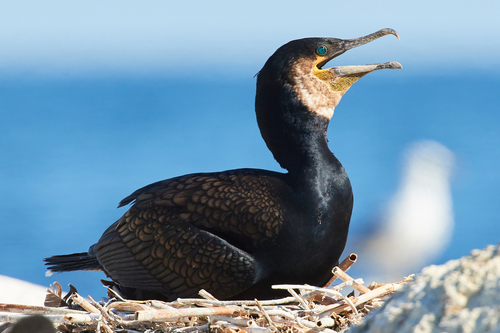
Great Cormorant
The Great Cormorant (Phalacrocorax carbo) is a widespread and adaptable seabird known for its remarkable fishing abilities and distinctive appearance. Found on every continent except Antarctica, it plays a crucial role in aquatic ecosystems as a top predator. In some cultures, particularly in East Asia, Great Cormorants have been trained for centuries to assist fishermen, showcasing a unique and long-standing relationship between humans and this species. Their sleek, black plumage and seemingly awkward gait on land belie their grace and power underwater.
70-102 cm
Length
121-160 cm
Wingspan
Least Concern
Conservation Status
Distribution
The Great Cormorant has one of the widest distributions of any bird species. It is found across Europe, Asia, Africa, Australia, and the eastern coast of North America. Migratory patterns vary; some populations are resident, while others undertake long migrations, often following coastlines or major river systems. They can be found at altitudes ranging from sea level to over 4,000 meters.
Lifespan
The average lifespan in the wild is around 11-15 years, although individuals can live much longer.
Great Cormorant's Habitat
Habitat Types
Coastal waters, Estuaries, Rivers, Lakes, Reservoirs, Wetlands
Climate Zones
Tropical, Subtropical, Temperate, Boreal
Adaptations
Great Cormorants possess several adaptations for their aquatic lifestyle. Their dense, wettable plumage reduces buoyancy, aiding in diving. They have powerful webbed feet for propulsion and a hooked bill for grasping slippery prey. A special gland near the eye helps them excrete excess salt.
Variations
Several subspecies are recognized, differing in size, plumage details, and geographic range. For example, *P. c. sinensis* (found in much of Asia) often has more extensive white cheek patches than the nominate *P. c. carbo* (found in Europe and North America).
Appearance
Breeding Plumage
Breeding adults develop white patches on their thighs and often have more pronounced white on the head and neck. Non-breeding adults are generally a glossy black-brown.
Seasonal Feather Changes
Plumage variations are primarily tied to the breeding cycle, with the most distinct differences seen during the breeding season.
Sex Based Plumage Differences
While both sexes share similar plumage, males often exhibit more intense coloration and larger white patches during the breeding season.
Notable Features
Hooked bill, Webbed feet, Glossy black plumage (in most subspecies), White cheek and thigh patches (during breeding season), Greenish or bluish eyes
Diet and Feeding
Primary Foods
Fish, Crustaceans, Amphibians, Mollusks
Foraging Behavior
Great Cormorants are pursuit divers, propelling themselves underwater with their powerful webbed feet. They typically forage in relatively shallow waters, diving for an average of 20-30 seconds, but can stay submerged for over a minute. They often hunt cooperatively, forming lines to herd fish.
Specializations
Their hooked bill is perfectly adapted for catching and holding slippery fish. Their wettable feathers reduce buoyancy, allowing for efficient diving.
Seasonal Diet Variations
Diet can vary depending on prey availability. In some regions, they may consume more crustaceans during certain times of the year.
Behavior
Social Structure
Great Cormorants are highly social birds, often forming large breeding colonies and roosting communally. Outside of the breeding season, they may form large flocks, particularly at good feeding sites.
Communication
Guttural croaks and grunts, Hissing sounds (during threat displays), Visual displays (wing-waving, head-bobbing)
Migration
Migration patterns vary greatly. Some populations are sedentary, while others migrate long distances. Northern populations tend to be more migratory, moving south for the winter.
Territorial or Group Behaviors
During the breeding season, Great Cormorants are highly territorial, defending their nest site from intruders. Outside of the breeding season, they are generally more gregarious.
Conservation
Threats
Habitat destruction, Pollution (including oil spills and plastic ingestion), Entanglement in fishing gear, Persecution by humans (due to perceived competition with fisheries), Climate change (affecting prey availability and breeding success)
Protection Programs
International agreements (e.g., the Agreement on the Conservation of Albatrosses and Petrels), National wildlife refuge programs, Habitat restoration projects
Local National Laws
Protected under various national and international laws, such as the Migratory Bird Treaty Act in the United States and the Birds Directive in the European Union.
Population Trend
Stable
Population Estimates
The global population is estimated to be 1.4 - 2.1 million individuals.
Interesting Facts
Great Cormorants can dive to depths of up to 45 meters (148 feet).
Although they typically forage in shallower waters, their diving capabilities allow them to exploit a wide range of underwater habitats.
Their feathers are not fully waterproof.
This allows them to reduce buoyancy and dive more easily, but it also means they must spend time drying their wings after fishing.
They are often seen perching with their wings outstretched.
This posture is thought to help them dry their feathers and regulate their body temperature.
In some parts of Asia, Great Cormorants have been used for fishing for centuries.
A ring is placed around the bird's neck to prevent it from swallowing larger fish, which are then retrieved by the fisherman.
Faqs about Great Cormorant
Why do cormorants stand with their wings spread?
They do this primarily to dry their feathers, as their plumage is not fully waterproof. This also aids in thermoregulation.
Are Great Cormorants endangered?
No, the Great Cormorant is currently classified as Least Concern by the IUCN. However, some local populations may face threats.
What do Great Cormorants eat?
Their diet consists primarily of fish, but they also consume crustaceans, amphibians, and other aquatic animals.
How deep can Great Cormorants dive?
They can dive to depths of up to 45 meters (148 feet), although they typically forage in shallower waters.
Do Great Cormorants migrate?
Some populations are migratory, while others are resident. Migration patterns vary depending on geographic location and food availability.
Copyright @ Nature Style Limited. All Rights Reserved.
 English
English